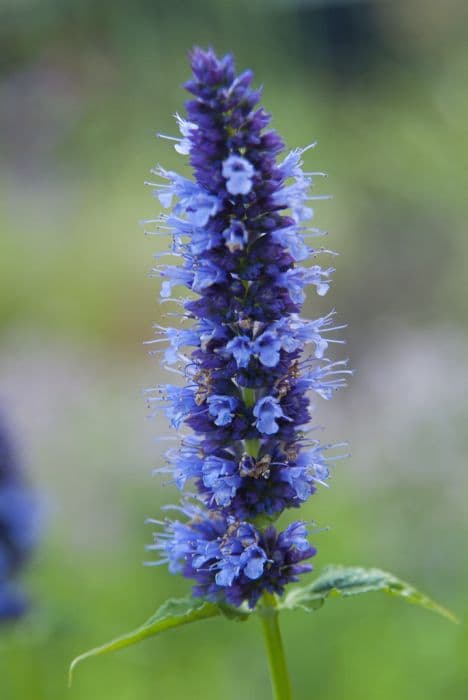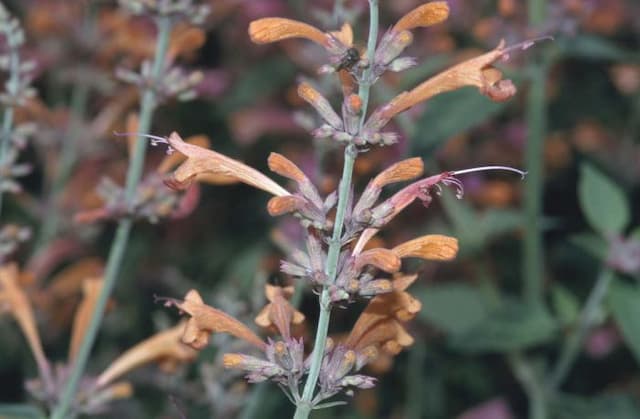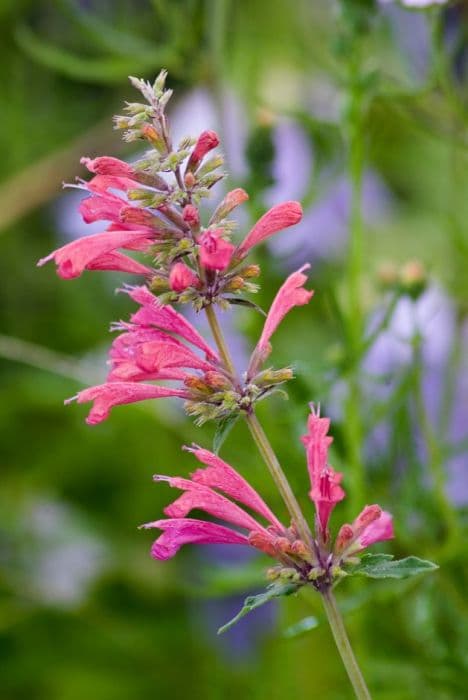Spanish lavender Lavandula stoechas Coco Deep Pink (Coco Series)
![French lavender [Coco Deep Pink]](/_next/image?url=https%3A%2F%2Fplants-admin.emdemapps.com%2Fimages%2Fplants%2F%2Fimages%2F604b620564ec6.png&w=3840&q=75)
ABOUT
The Lavandula stoechas Coco Deep Pink, commonly known as Spanish Lavender or French Lavender, is a striking variety noted for its vibrant and deep pink flower heads. Unlike the more common English lavender, this variety features plump, elongated blooms, vividly colored, which are often likened to small pineapples due to their shape. Atop these blooms are larger, petal-like bracts that are also deep pink and resemble butterfly wings fluttering above the flowers. These bracts are one of the most distinctive characteristics that set the Spanish Lavender apart, adding an ornamental flair to the plant's overall appearance. The foliage of the Spanish Lavender is gray-green, which provides a delicate contrast to the intense deep pink flowers. The leaves are typically lance-shaped, adding to the plant's texture with their slightly toothed and furry surface. Together, the dazzling flowers and complementary foliage create a lush, vibrant display that is not only a feast for the eyes but also attracts an array of beneficial pollinators, such as bees and butterflies, to the garden. Spanish Lavender emits a pleasant scent, which is a blend of a traditional lavender aroma with hints of other herbaceous tones. This fragrance is stronger when the leaves are brushed or on warmer days when the oils in the plant's foliage become more volatile. In addition to its sensory appeal, the Spanish Lavender's dense and bushy growth habit contributes to its popularity as a garden plant; it forms a mound of color and scent that is a standout in any planting arrangement.
About this plant
 Names
NamesFamily
Lamiaceae.
Synonyms
Spanish Lavender, French Lavender, Butterfly Lavender, Topiary Lavender, Mediterranean Lavender.
Common names
Lavandula stoechas Coco Deep Pink.
 Toxicity
ToxicityTo humans
Spanish lavender is not typically considered toxic to humans. However, consuming any part of the plant in large quantities might give rise to discomfort or adverse reactions due to the presence of essential oils and other plant compounds. Ingestion might cause mild discomfort such as stomach pain, nausea, vomiting, or diarrhea in sensitive individuals. It is worth mentioning that although the plant is generally safe, individuals with allergies or sensitivities to lavender should exercise caution.
To pets
Spanish lavender is generally not considered toxic to pets, but caution should be exercised as some pets might be more sensitive to various plants than others. If a pet ingests a large amount of the plant, they may experience mild gastrointestinal upset, which could lead to symptoms like vomiting or diarrhea. As with any non-food plant, it is best to prevent pets from ingesting it to avoid any potential problems. If you suspect your pet has ingested a significant amount of Spanish lavender, it is advisable to consult with a veterinarian.
 Characteristics
CharacteristicsLife cycle
Perennials
Foliage type
Evergreen
Color of leaves
Gray-green
Flower color
Deep pink
Height
1-2 feet (30-60 cm)
Spread
1-3 feet (30-90 cm)
Plant type
Shrub
Hardiness zones
8
Native area
Mediterranean
Benefits
 General Benefits
General Benefits- Aesthetic Appeal: Adds vibrant deep pink color to gardens and landscapes.
- Fragrance: Emits a pleasant and soothing scent, enhancing the sensory experience of a space.
- Attracts Pollinators: Draws in bees, butterflies, and other beneficial insects, supporting local ecosystems.
- Drought Tolerant: Once established, it requires minimal water, making it suitable for xeriscaping and arid environments.
- Low Maintenance: Generally easy to care for and does not require frequent fertilization or pruning.
- Deer Resistant: Less likely to be eaten by deer, reducing the need for protective measures.
- Long Blooming: Produces flowers for an extended period, providing lasting color throughout the growing season.
- Compact Growth: Suitable for small gardens, borders, and containers due to its relatively small size.
- Evergreen: Maintains its foliage throughout the year, providing continuous greenery.
 Medical Properties
Medical Properties- Antiseptic: Extracts have been used for their antiseptic properties.
- Anti-inflammatory: Contains compounds that could help reduce inflammation.
- Anxiolytic: Essential oils are used in aromatherapy to alleviate anxiety.
- Antimicrobial: Has shown potential in fighting certain bacteria and fungi.
- Antispasmodic: Traditionally used to relieve muscle spasms and cramps.
- Carminative: Can be used to alleviate gas and bloating.
- Analgesic: Essential oil sometimes used for its pain-relieving properties.
 Air-purifying Qualities
Air-purifying QualitiesThis plant is not specifically known for air purifying qualities.
 Other Uses
Other Uses- Lavender Sachets: The flowers of Spanish Lavender can be dried and placed in small pouches to create sachets for scenting drawers and wardrobes, which may also help deter moths.
- Natural Insect Repellent: The plant can be positioned around outdoor seating areas or planted in the garden to help repel mosquitoes and other insects naturally.
- Flavoring Agent: Lavender leaves and buds from the Coco Deep Pink variety can be used to infuse sugars or salts with a floral flavor for use in gourmet cooking.
- Crafting and Potpourri: Dried flowers and leaves are often incorporated into potpourri mixes or used in various crafting projects for their scent and color.
- Decorative Arrangements: The vibrant pink blooms can be used in fresh or dried floral arrangements to add a pop of color and a pleasant fragrance to any room.
- Fragrance Production: The essential oil, while more commonly extracted from other lavender varieties, can also be derived from Spanish Lavender and used in perfumery.
- Culinary Garnish: Fresh flowers can add an edible and aromatic garnish to desserts and cocktails, providing a unique twist to culinary presentations.
- Photographic Subject: Due to its striking deep pink color, Spanish Lavender is often used as the subject in botanical and garden photography.
- Wildlife Attraction: Planting Spanish Lavender can attract beneficial pollinators like bees and butterflies to the garden, supporting local ecosystems.
- Relaxation Aid: Bundles of Coco Deep Pink Lavender can be added to a warm bath for a visually appealing and calming soak.
Interesting Facts
 Feng Shui
Feng ShuiThe Spanish lavender is not used in Feng Shui practice.
 Zodiac Sign Compitability
Zodiac Sign CompitabilityThe Spanish lavender is not used in astrology practice.
 Plant Symbolism
Plant Symbolism- Calmness: Lavender is commonly associated with tranquility and serenity. The Coco Deep Pink variety, like other lavender plants, is often thought to bring about a peaceful atmosphere and can be used to reduce anxiety and promote relaxation.
- Healing: Historically, lavender has been used for its medicinal properties. The plant symbolizes healing and is believed to aid in soothing physical and emotional discomfort.
- Purity: The clean and fresh scent of lavender is often linked with purity and cleanliness. Thus, giving someone this plant could symbolize a wish for purity or a fresh start.
- Devotion: Lavender is also a symbol of devotion, loyalty, and undying love. Gifting this plant might be seen as an expression of one's deep commitment and faithful feelings.
- Protection: In some cultures, lavender is believed to ward off evil spirits. Keeping this plant in the home would hence signify a desire for protection from negative energies.
- Royalty: The color purple, which is prevalent among lavender plants, is traditionally associated with nobility and elegance. This could imply a regal quality or a sense of majesty connected to the plant.
 Water
WaterSpanish Lavender should be watered deeply but infrequently. It thrives in well-draining soil and does not like to remain wet for extended periods. Generally, watering once every 1 to 2 weeks is sufficient, but this schedule should be adjusted depending on weather conditions and soil type. During hot, dry spells, water may be required more frequently, and less during cool, damp periods. It's important to provide about a gallon of water at each watering session so that the moisture reaches deep into the root zone, promoting strong root growth.
 Light
LightSpanish Lavender prefers full sun, aiming for at least 6 to 8 hours of direct sunlight each day. The perfect spot would be in an area where it can receive unobstructed sunlight from the morning through to the afternoon. Partial shade can be tolerated but may result in fewer flowers and less dense foliage.
 Temperature
TemperatureSpanish Lavender can withstand a range of temperatures but performs best when the climate is warm. It has a hardiness for regions where temperatures do not typically fall below 10 degrees Fahrenheit. Ideal growing conditions are between 60 and 70 degrees Fahrenheit, but it can survive occasional dips into the 50s and high heat well above 70 degrees Fahrenheit.
 Pruning
PruningSpanish Lavender should be pruned to maintain shape, encourage bushier growth, and promote more vigorous flowering. Pruning should be done in early spring before new growth starts and again after the first flush of flowers has faded. Remove about one-third to one-half of the plant's height, shaping as desired. Pruning is typically needed once or twice a year.
 Cleaning
CleaningAs needed
 Soil
SoilThe French Lavender Coco Deep Pink thrives in well-draining soil with a mix of two parts potting soil, one part coarse sand, and one part compost. Ensure the soil pH is slightly alkaline, between 6.5 and 8.0.
 Repotting
RepottingFrench Lavender should be repotted once every two or three years to refresh the soil and provide room for growth.
 Humidity & Misting
Humidity & MistingFrench Lavender prefers low to moderate humidity levels, as too much humidity can lead to fungal diseases.
 Suitable locations
Suitable locationsIndoor
Place in bright light and ensure good air circulation for indoor French Lavender.
Outdoor
Plant in full sun with well-drained soil for outdoor French Lavender.
Hardiness zone
8-9 USDA
 Life cycle
Life cycleThe life cycle of the Lavandula stoechas 'Coco Deep Pink', commonly known as French Lavender or Spanish Lavender, begins with seed germination, typically in spring, in a well-drained, warm soil. Following germination, seedlings emerge and develop into young vegetative plants, characterized by the growth of grey-green, aromatic leaves. As the plants mature, they enter the flowering stage, usually in late spring to early summer, producing deep pink, tufted flower heads atop long stems, which are highly attractive to bees and butterflies. After pollination, often by insects, the flowers develop into small seed capsules that eventually dry and release seeds, completing the reproductive cycle. The plant enters a period of dormancy in colder climates during autumn and winter, with reduced growth and survival of the fittest individuals. Pruning after flowering can encourage a second bloom and stimulate new growth for the following season.
 Propogation
PropogationPropogation time
Spring-Early Summer
Lavender, particularly the Lavandula stoechas 'Coco Deep Pink', is often propagated by taking cuttings. This method is commonly done in late spring or early summer when the plant is growing vigorously. One would cut a 3-4 inch (approximately 7.5-10 cm) stem segment just below a node, remove the lower leaves, and dip the cut end in rooting hormone. The stem is then planted in a mix of peat and perlite or coarse sand to provide good drainage. The cutting should be placed in indirect light and kept consistently moist until roots develop, which usually takes a few weeks. Covering the cutting with a plastic bag can help maintain humidity, but it is critical to ensure there is some ventilation to prevent rot. After rooting, the plant can be transplanted into a larger pot or directly into the garden.






![Bugle [Sugar Plum]](/_next/image?url=https%3A%2F%2Fplants-admin.emdemapps.com%2Fimages%2Fplants%2F%2Fimages%2F604b597956a55.png&w=640&q=75)
![Bugle [Princess Nadia]](/_next/image?url=https%3A%2F%2Fplants-admin.emdemapps.com%2Fimages%2Fplants%2F%2Fimages%2F604b5806e268c.png&w=640&q=75)

